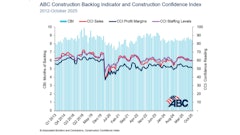
For a lot of you, your annual business cycle is coming to a close and you will be preparing for year end. That means dealing with inventories, overhead allocations, billing adjustments, bonus pools, employee benefit plans, tax planning, loan renewals and covenant calculations, as well as the year-end financial statements and tax returns — all of which will take time and money to resolve.
A well-managed construction or service company will have most of these items under control because they have been “adjusting” throughout the year. They will have final financials available for their auditor sometime in late January, and in return will receive their audit report by March 15 along with the annual federal and state income tax returns. This is a nice place to be, giving management more time to plan for the upcoming year and adjust expenses and other issues that need “fixing,” so that the benefits achieved are received right out of the gate for the following year’s reporting.
Steps to Get Ahead of Year End
Closing the year-end books is time consuming, but some of the steps required can be completed beforehand, reducing the workload.
Step 1: Get A Count
For example, inventories of equipment, parts and other assets that show up on the balance sheet should be counted at least once a year and adjusted. But this does not mean it has to be done in December. Try another month to complete this process.
As long as you have the documentation that you did the counts and made any necessary adjustment for the month the counts were made, it should be good enough for your auditors — unless you’re susceptible to material differences between your book and the count results. If so, you need to take care of your internal policies dealing with those accounts and get them corrected once and for all. Not doing so could be costing you a lot of money in terms of “lost” items or job interruptions because you don’t have the part or equipment you need when your books say you do.
Step 2: Have Records Done Monthly
The same goes for other balance sheet assets such as the bank reconciliation; cleaning up AR and collecting past due accounts; reviewing prepaid items; and those thousand other tiny account balances that just seem to show up on the books without anyone really knowing why. The bank record should be completed and reviewed monthly and all miscellaneous items accounted for. Your system should be able to do this; QuickBooks will also complete this task. There is no excuse to not complete this task in a timely manner.
Accounts receivable balances can get out of hand if the billing and collection process is not on sound footing. This is your money we’re talking about — managing AR should be a top management priority. Get the billing out!
Step 3: Stay on Top of Problem Accounts
Deal with questions and problem accounts daily. Book any required adjustments and issue credit where necessary. Manage your lien rights. Assign someone to collect the money.
Near year end, go over all major accounts to ensure there are no problems. Do the same for smaller accounts. Decide which accounts are bad and either adjust your reserve or write them off. This is something you can accomplish at the end of the third quarter.
Step 4: Check Your List
Management should review the equipment list to see if any unit needs to be replaced, repaired or sold just to get it off the books. It doesn’t do you any good to carry units that aren’t producing revenue.
I like to have a desktop appraisal of equipment to know what it is worth. I compare the appraised value to the book value to determine if I have a hidden “value” not reflected on my books. If the fleet is worth more than the book value, the bank will love to get that report because it may help with financing efforts.
Step 5: Review Your Liabilities
A similar process should take place regarding the liability side of the balance sheet. Review AP and credit card balances to see who and what you owe. Do the balances make sense? Do you have vendor statements to compare to your book balances? Credit card statements require a similar effort.
Again, this is your money we’re talking about. Are there credits you could be applying? Have you received all the credits you have coming? I always find that reviewing the month-end AP detail is quite revealing and raises quite a few questions.
Bank loan terms, covenant terms and the collateral values required all need reviewing at least once a year. If bank terms are not working for you, I suggest you shop around and find a bank with significant construction and contractor presence. They are out there.
Other accrued expense accounts require careful review and adjustment. Have your accounting department explain what is in each account and state that the balance is current.
Once these steps are completed, you should be in pretty good shape for the year end. And if you spread these internal audit steps throughout the year and make necessary adjustments, your year-end financial statement should be on your desk by the end of January.
More Critical Pre-Year-end Cleanup
In terms of the income statement, cleaning up the balance sheet should eliminate a lot of work. Before the end of the year, review any overhead allocation adjustments that must be agreed upon to apply to work in the New Year. The same goes for billing adjustments that take payroll and cost increases into account. And of course, the sooner you have the current year income statement results, the sooner you can adjust billing and overhead accounting for 2020.
One more big item to consider is your potential tax liability for the current year and estimated tax requirements for the following year. The current year liability should be available before year end. No excuses here; it is a must.
And don’t forget about the Wayfair sales tax decision (see https://bit.ly/31CDalN). If you’re buying parts online and are the end user of those parts, there probably should be a tax on them. Just ask your accountant about the effects of Wayfair on your business.
The goal is to get and keep control of your financial position by spreading out the internal audit process and speed up the year-end close. If you can do this, I assure you a better night’s sleep.


















